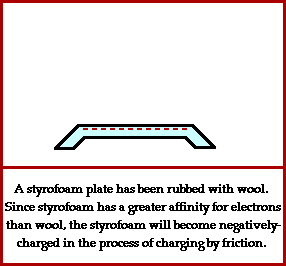
Charging an
Electrophorus by Induction Using a Negatively-Charged
Object
A GIF Animation
A common physics demonstration involves the charging of an
aluminum pie plate by the process of induction. The demonstration
typically involves the following steps.
- Acquire a charged object (e.e., a balloon or styrofoam
plate) made of a non-conducting material.
- Using an insulating handle on the aluminum plate, bring the
aluminum plate near to but not touching the styrofoam plate.
- Touch the rim of the aluminum plate with your finger.
- Move the aluminum plate away from the charged object.
A styrofoam plate is often used as the charged object to
induce a charge separation within the aluminum plate. If the
styrofoam plate is rubbed with wool or animal fur, then the styrofoam
acquires a negative charge. Having a greater electron affinity than
the wool (or animal fur), the styrofoam will attract electrons away
from the atoms of the wool. Thus, the styrofoam becomes
negatively-charged.
The animation below depicts the result of the remainder of this
induction procedure.

When the aluminum plate is held near the negatively-charged
styrofoam plate, electrons within the aluminum plate will be repelled
by the negatively-charged styrofoam. These electrons will move from
the bottom surface of the aluminum plate to the rim of the aluminum
plate. This leaves the bottom of the aluminum plate with an excess of
positive charge and the rim of the aluminum plate with an excess of
negative charge. It could be said that the styrofoam has served to
polarize the aluminum plate - i.e., to separate its positive
charge from its negative charge. While there may be a separation of
charge within the aluminum plate, the overall charge of
the plate is zero. Once the aluminum plate is touched, electrons move
from the aluminum plate to the ground. It is at this instant
that the aluminum plate acquires an overall positive charge. This
excess of positive charge remains localized near the bottom of the
aluminum plate due to its attraction to the styrofoam plate. As the
aluminum plate is lifted away from the styrofoam plate, there is a
movement of remaining electrons within the aluminum plate such that
the excess positive charge becomes uniformly distributed about the
aluminum plate.
Additional information on physical descriptions of
electrostatic phenomenon will soon be available at
The
Physics Classroom.
This page was created by
Tom
Henderson of
Glenbrook South
High School.
Comments and suggestions can be sent by e-mail to
Tom
Henderson.
This page last updated on 2/9/98.
